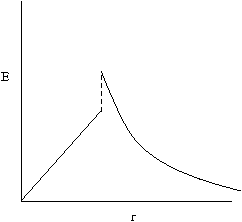Consider a non-conducting sphere with a uniform charge density ρ. Since the material is a non conductor, the charge will not move around. The non-conductor, is also known as a dielectric. If it is a linear dielectric, it will have a dielectric constant εr, also denoted by K, which is greater than 1. In this case, the bound charge density is proportional to the free charge ρ. Thus the electric field inside is reduced by that factor.

Electric Field of a uniformly charged sphere
The above figure shows the usual analysis of the problem. Note that the field is identical to that of a sphere of uniform mass density, a usual textbook approximation for the interior of the earth (although the density of the earth is highly non-uniform, increasing to a value of 13 g/cc at the center). Of course, since there is no negative mass, there is no question of polarization or some such in the case of the earth.

Electric Field inside a uniformly charged dielectric
The electric field is discontinuous at the surface as there is surface charge buildup there. The field outside is unchanged from the original, but the field inside is reduced.
The real question is: what is meant by charge density? If it is the total charge density, then as Gauss’s law is always given by , and the electric field is immediately obtained. If the charge density is the free charge density, then the value of
is not immediately known, so that the field is different. Only in the case of a linear dielectric under very special circumstances can we give the “modification” of Gauss’s law as
where ε is the absolute permittivity of the medium. These include that the material be a linear dielectric.
If the question is posed as follows: a sphere of radius R carries a charge Q, uniformly distributed in the volume. Plot the electric field vs r, the distance from the center of the sphere. Can we avoid the buildup of surface charge in the case of a linear dielectric? I think not. If the statement is about a charge density ρ = ρ0 for 0 ≤ r ≤ R, and zero everywhere else, then there is no ambiguity at all. A surface charge will involve an infinite volume charge density there, so that is impossible. Another way of stating the same thing is this: consider a charge Q distributed uniformly over a spherical region of radius R.